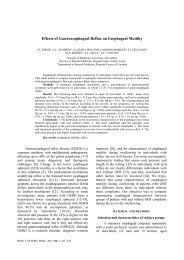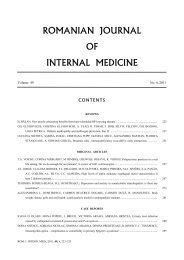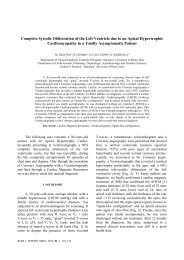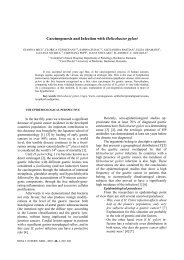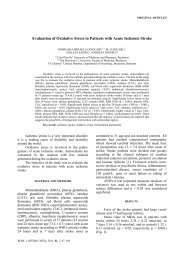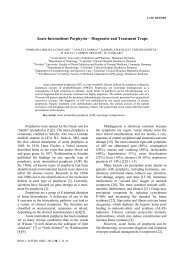Cardiac Involvement in Myasthenia Gravis - Romanian Journal of ...
Cardiac Involvement in Myasthenia Gravis - Romanian Journal of ...
Cardiac Involvement in Myasthenia Gravis - Romanian Journal of ...
Create successful ePaper yourself
Turn your PDF publications into a flip-book with our unique Google optimized e-Paper software.
9 <strong>Cardiac</strong> <strong>in</strong>volvement <strong>in</strong> myasthenia gravis 187<br />
Most <strong>of</strong> the studies concern<strong>in</strong>g ECG changes<br />
and myocardial <strong>in</strong>filtration <strong>in</strong> myasthenia gravis<br />
were conducted before the era <strong>of</strong> coronary<br />
angiography, so that there is difficult to <strong>in</strong>terpretate<br />
them especially <strong>in</strong> thymoma patients, who are<br />
usually older male patients, with a high probability<br />
<strong>of</strong> ischemic heart disease. A contemporary review<br />
<strong>of</strong> these data with modern technique would be <strong>of</strong><br />
real <strong>in</strong>terest.<br />
In the second case we reported, myocarditis is a<br />
plausible cause <strong>of</strong> ECG evolv<strong>in</strong>g changes <strong>in</strong> the<br />
context <strong>of</strong> angiographically normal coronary arteries.<br />
Some technical limits <strong>in</strong> the paracl<strong>in</strong>ical<br />
<strong>in</strong>vestigations have led to the impossibility <strong>of</strong><br />
establish<strong>in</strong>g a certa<strong>in</strong> diagnosis: lack <strong>of</strong> quantitative<br />
measurements <strong>of</strong> tropon<strong>in</strong> level <strong>in</strong> dynamics, lack<br />
<strong>of</strong> ECG for comparison, BNP measurement <strong>in</strong> the<br />
acute episode, <strong>of</strong> myocardial sc<strong>in</strong>tigraphy with<br />
monoclonal Indium labeled antimyos<strong>in</strong> antibodies<br />
or Galium sc<strong>in</strong>tigraphy or cardiac MRI exam.<br />
A recent study [19] suggested that functional<br />
changes are frequent <strong>in</strong> myasthenia gravis. Autonomous<br />
nervous system, both sympathetic and parasympathetic,<br />
is affected <strong>in</strong> myasthenia gravis, but<br />
the impact <strong>of</strong> these changes on heart function is<br />
still unclear. It has also been proven that the<br />
patients with myasthenia gravis and autoimmune<br />
autonomous neuropathy [20] have antibodies<br />
aga<strong>in</strong>st the nicot<strong>in</strong>ic receptor for acetylchol<strong>in</strong>e<br />
located <strong>in</strong> the skeletal muscle (a classical f<strong>in</strong>d<strong>in</strong>g <strong>in</strong><br />
myasthenia gravis) and specific antibodies aga<strong>in</strong>st<br />
the acetylcol<strong>in</strong>e receptors located <strong>in</strong> the ganglia on<br />
the nerves. This f<strong>in</strong>d<strong>in</strong>g may expla<strong>in</strong> the rare, but<br />
possible cl<strong>in</strong>ical association between myasthenia<br />
gravis and autonomous system dysfunction.<br />
Another important part is the possible<br />
iatrogenic heart <strong>in</strong>volvement dur<strong>in</strong>g treatment with<br />
chol<strong>in</strong>esterase <strong>in</strong>hibitors which may cause<br />
bradycardia, hypotension, syncope, atrioventricular<br />
heart blocks due to the <strong>in</strong>creased quantity <strong>of</strong><br />
acethylcol<strong>in</strong>e <strong>in</strong> the synapse. Some reports mention<br />
cases <strong>of</strong> vasospastic ang<strong>in</strong>a [21], acute myocardial<br />
<strong>in</strong>farction due to coronary artery spasm dur<strong>in</strong>g the<br />
col<strong>in</strong>ergic crisis [22] and proarrythmic effects <strong>of</strong><br />
chol<strong>in</strong>esterase <strong>in</strong>hibit<strong>in</strong>g drugs [23].<br />
In the first reported case we do not have enough<br />
data to strictly l<strong>in</strong>k the conduction abnormalities to<br />
the pathogeny <strong>of</strong> the disease (myocarditis or<br />
autonomous nervous system dysfunction) because<br />
<strong>of</strong> lack <strong>of</strong> immunologic panel <strong>of</strong> the patient. The<br />
patient followed a long treatment (2001–2008) with<br />
col<strong>in</strong>-esterase <strong>in</strong>hibitors, a iatrogenic etiology must<br />
be considered <strong>in</strong> this case, with no possibility <strong>of</strong><br />
stopp<strong>in</strong>g or decreas<strong>in</strong>g the dosage due to the<br />
relaps<strong>in</strong>g <strong>of</strong> myasthenic symptoms.<br />
In the cases <strong>of</strong> symptomatic heart blocks with<br />
syncope <strong>in</strong> patients with myasthenia gravis under<br />
treatment with col<strong>in</strong>esterase <strong>in</strong>hibitors the usual<br />
management implies permanent pac<strong>in</strong>g, as <strong>in</strong> the<br />
described case.<br />
A recent published case report describes the<br />
situation <strong>of</strong> a patient with myasthenia gravis under<br />
piridostigm<strong>in</strong>e treatment who developed high grade<br />
atrioventricular block with frequent episodes <strong>of</strong><br />
syncope. In this case the authors chose the<br />
simultaneous treatment with hiosciam<strong>in</strong>e, a<br />
muscar<strong>in</strong>ic antagonist used to block the deleterious<br />
chol<strong>in</strong>ergic side effects. Under the association <strong>of</strong><br />
therapy the atrioventricular block completely<br />
disappeared, there was no further syncope, thereafter<br />
avoid<strong>in</strong>g the permanent pac<strong>in</strong>g. This situation is an<br />
isolated report, moreover the treatment with<br />
hiosciam<strong>in</strong>e is not available <strong>in</strong> Romania.<br />
There is also a case report <strong>of</strong> atrioventricular<br />
block and pericardial effusion <strong>in</strong> a myasthenia gravis<br />
patient, with favourable course under immunosuppressive<br />
therapy and plasmapheresis [4].<br />
In the first case we considered that the patient<br />
had an <strong>in</strong>creased risk <strong>of</strong> sudden death, no matter<br />
the cause <strong>of</strong> the conduction abnormalities and<br />
chose a permanent pac<strong>in</strong>g attitude, even if the<br />
current guidel<strong>in</strong>es do not <strong>in</strong>clude myasthenia gravis<br />
among the neuromuscular disorders with conduction<br />
abnormalities that impose pac<strong>in</strong>g. Accord<strong>in</strong>g to the<br />
ACC/AHA 2002 guidel<strong>in</strong>es for implantation <strong>of</strong><br />
cardiac pacemakers and antiarrhythmia devices the<br />
pac<strong>in</strong>g <strong>in</strong>dication <strong>in</strong> our patient is class IIb, level <strong>of</strong><br />
evidence B. The guidel<strong>in</strong>es mention that <strong>in</strong><br />
neuromuscular disorders like myotonic muscular<br />
dystrophy, Kearns Sayre syndrome, Erb dystrophy<br />
and peronier muscular atrophy, the presence <strong>of</strong> an<br />
atrioventricular block <strong>of</strong> any grade (<strong>in</strong>clud<strong>in</strong>g grade<br />
I atrioventricular block) with or without symptoms<br />
permanent pac<strong>in</strong>g is <strong>in</strong>dicated given the impredictable<br />
progression <strong>of</strong> conduction abnormalities <strong>in</strong> these<br />
patients. Accord<strong>in</strong>g to the ESC Pac<strong>in</strong>g and CRT<br />
Guidel<strong>in</strong>es, neuromuscular disorders with second or<br />
third degree atrioventricular block represent a class I<br />
level <strong>of</strong> evidence B recommendation for cardiac<br />
pac<strong>in</strong>g, while the association with first-degree<br />
atrioventricular block is a class IIb level <strong>of</strong> evidence<br />
B recommendation.



